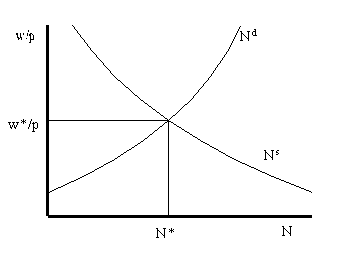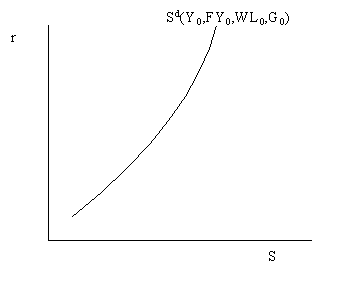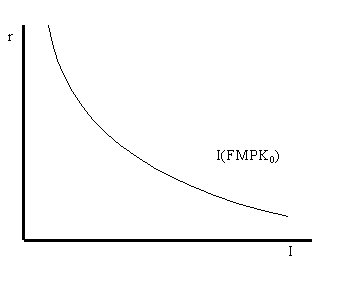Econ 301 Lecture 5
Reading: AB,
chapter 3; chapter 8, section 5 (skim - advanced section)
Last updated on July 18, 1996.
Contents
Types of Unemployment
- Frictional Unemployment:
unemployment caused by workers searching for jobs and
firms searching for workers.
- Structural Unemployment:
long-term chronic unemployment that exists when the
economy is not in a recession. The main causes of
structural unemployment are: (1) the number of low
skilled workers exceeds the number of low skilled jobs
(dual labor market idea); (2) some sectors of the economy
are contracting while others are expanding and the
contracting industries create unemployment.
- Natural Rate of Unemployment:
unemployment rate consistent with full employment =
frictional rate + structural rate = u*. Currently the
natural rate is estimated to be somewhere between 5.5%
and 6.5%. However, it is not estimated very precisely. (Note:
equilibrium values are denoted with a superscript
"*" instead of an overbar since I can't get
overbars to print in HTML.)
- Cyclical Unemployment:
actual rate of unemployment - natural rate of
unemployment = u - u*. The cyclical rate of unemployment
is the unemployment created by recessions and booms.
During recessions, u - u* > 0; during booms, u - u*
< 0.
- Actual Unemployment Rate:
natural rate + cyclical rate = u = u* + (u - u*).
- NAIRU:
non-accelerating inflation rate of unemployment = rate of
inflation consistent with stable prices/inflation =
natural rate of unemployment. The NAIRU and the natural
rate are the same thing. As we shall see, the natural
rate of unemployment (NAIRU) is the rate of unemployment
that exists when inflation is neither increasing nor
decreasing. When the economy is booming, cyclical
unemployment is positive and inflation tends to
accelerate; when the economy is in recession, cyclical
unemployment is negative and inflation tends to
decelerate.
Graphical illustration of u*

The natural rate of unemployment, u*, is the unemployment rate
that occurs when the labor market is in equilibrium; i.e. when
employment is N*.
Unemployment Statistics
- Labor force (LF):
number of employed individuals (E) + number of unemployed
individuals seeking work (U).
- Not in the labor force
(NLF): those individuals neither employed nor unemployed
and not seeking work.
- Adult population:
LF + NLF.
- Unemployment rate:
u = U/(E + U). Note that the unemployment rate changes
whenever U or E changes.
[insert pie chart of unemployment statistics here]
Counter Intuitive Facts About
Unemployment
- Most spells of unemployment (i.e., time spend unemployed)
are short - about 2 months
- Most people who are unemployed on a given date are
experiencing long unemployment spells (i.e., have been
unemployed for a long time - about 1 year).
Overview
Our discussion so far of the labor market and the production
function represents the supply-side of the economy independent of
the overall level of aggregate demand. Changes in factors that
affect labor demand (Nd), labor supply (Ns)
and the production function (F) change the potential supply, Y*,
of the economy independent of demand. (Note: variables
with supercript "*" are equilibrium values.)
The demand-side of the economy focuses on the aggregate demand
for goods and services independent of potential supply. To
simplify our analysis, we assume that there is no foreign sector
to the economy. Then aggregate demand for goods and services,
using the expenditure approach, is defined as: Yd = Cd + Id + G0, where Cd
= demand for consumption goods, Id
= demand for investment goods and G0
= exogenous government spending on goods and services. Here, NX = 0 since there is no foreign sector.
Modeling the aggregate demand for goods and services thus
requires modeling the demand for consumption goods and the demand
for investment goods. However, since desired national saving is
defined as Sd = Yd -
Cd - G0 we may also focus on
modeling saving behavior instead of consumption behavior.
Aggregate demand, the desired amount of aggregate expenditure,
can be discussed in terms of desired consumption expenditure, Cd,
and desired investment, Id, or in terms of desired
national saving, Sd, and desired investment. The
reason is that we define desired national saving as: Sd = Y - Cd - G0.
Behavioral model for national saving
By definition, saving is what is left over from current income
after we have decided how much to consume. Decisions about
consumption and saving involve decision about how much to consume
today and how much to consume in the future. After all, the
reason we save is so that we have wealth in the future, when we
are no longer working, so that we can maintain consumption.
Accordingly, any reasonable model for consumption and saving must
take into consideration factors that influence our consumption
today and our consumption in the future. Our model for national
saving (private saving plus public saving) is of the form:

where
- r = real interest rate
- Y = real GDP (income)
- Ye = expected future income
- WL = wealth
- G = government spending.
Remarks
- As r increases the return to saving increases so desired
saving increases and consumption decreases (holding
income fixed). Also, a higher real interest reduced
interest sensitive consumption (big ticket items like
cars, refrigerators etc).
- As Y increases both desired saving and consumption
increase. Generally, individuals consume more when their
current income rises. A general rule of thumb is that
consumption increases by about 90 cents for every dollar
increase in income. Therefore, saving increases by about
10 cents for every dollar increase in income.
- As FYe increases, while current income stays
fixed, consumption tends to rise so that saving falls.
- Increases in G leads to decreases in savings since Sd
= Y - Cd - G0.
Income and substitution effects
Increases in the real interest rate affect desired saving in
two different ways:
- Substitution effect: As r increases, the return to saving
increases and this leads individuals to substitute
current consumption for future consumption so that saving
increases.
- Income effect: As r increases, for a target saver
(someone who is saving for a particular target like a
house), the target can be achieved with a smaller pool of
saving. If individuals prefer more current consumption to
future consumption than an increase in r will lead to
less saving today and more consumption. For example, to
have $10,000 in one year when r = 5% requires one to save
$9,524 = $10,000/(1.05). If r increases to 10% then one
only has to save $9,091 = $10,000/(1.10). Consumption can
go up by almost $500 and the desired target can still be
achieved.
Graphical representation of desired
saving
The relationship between desired national saving and the real
interest holding fixed Y, FYe, WL and G is called the
savings curve and is illustrated below:

The savings curve is steep because the substitution effect is
empirically very weak: it takes a very large increase in the real
interest rate to induce individuals to save more. The savings
curve shifts out and to the right (savings increases) when either
Y, FYe or WL increases. Conversely, the savings curve
shifts up and left (savings decreases) whenever G increases.
Determinants of Investment Behavior
Recall, investment expenditure refers to the purchase of
physical capital for the purpose of increasing future output. In
the National Income and Product Accounts, investment is broken
into business fixed investment (investment in equipment and
structures) and inventory investment (purchase of unsold
production). In this section we only model the demand for
business fixed investment.
Some definitions
- I(t) = gross investment
during year t (flow variable).
- K(t) = capital stock at the
beginning of year t (stock variable).
- K(t+1) = capital stock at
the beginning of year t+1.
- d = rate of depreciation of
the capital stock (e.g. d = 10%).
- Net investment = gross investment -
depreciation = K(t+1)-K(t) = I(t) - d*K(t), where
K(t+1)-K(t) is the net change in the capital stock from
year t to year t+1; I(t) is gross investment; and d*K(t)
is the amount by which the capital stock in year t
depreciates or wears out.
Example
Let K(1995) = $100 billion, K(1996) = $110 billion and d =
10%. Net investment is equal to K(1996)-K(1995) = $10 billion.
The depreciation of the capital stock over 1995 is 0.10*$100
billion = $10 billion. Then gross investment over 1995 is:
I(1995) = net investment + depreciation = $10 billion + $10
billion = $20 billion.
Behavioral Model for Gross Investment
Firms invest in physical capital when they want to expand the
scope of operation and production. Firms decide to take on
investment projects when the expected benefits of investment
(returns to investment) outweigh the expected costs. This
decision is called the capital budgeting decision and it is
discussed in great detail in courses in financial economics. For
our purposes, we simply need to recognize that firms invest when
the expected net benefits from investment projects is positive.
The textbook goes into a detailed discussion of how firms weigh
the costs and benefits of an investment project and I will just
summarize the main results here:
- The expected return from an investment project is
measured by the expected future marginal product of
capital (FMPK) that is
generated by the investment. Whenever FMPK is high,
desired investment tends to increase.
- Most firms need to borrow in order to finance large
investment projects. The expected real interest rate, r, captures this borrowing cost to
firms. When r is high, the cost of borrowing is high and
desired investment tends to decrease.
Our behavioral model for investment is given by

and is given graphically by

As the above graphs shows, for a fixed level of FMPK desired
investment is low when the real interest rate, r, is high and
desired investment is high when the real interest rate is low.
The investment graph will shift up and to the right when FMPK
increases and it will shift down and to the left when FMPK
decreases.





